Succois 2016
by devadmin | October 13, 2016 9:07 pm
 Shoin: It was the Oisvorfer’s intention to write a mamish brand new review for the upcoming Yom Tov of Sukkis. At the very last minute, because the Oisvorfer is mamish oisgimatted (wiped out) from building the Sukkah this morning, it was decided to recycle a Sukkis piece written way back in 2012. Why davka 2012? Because back then, readership, now hovering at 500,000 keyn yirbu (so it should increase), was much smaller and most of you mistama missed that piece. Grada each Sukkis review was mamish a gem and Oisvorfer chasiddim can find others at www.oisvorfer.com. You will mamish enjoy.
Shoin: It was the Oisvorfer’s intention to write a mamish brand new review for the upcoming Yom Tov of Sukkis. At the very last minute, because the Oisvorfer is mamish oisgimatted (wiped out) from building the Sukkah this morning, it was decided to recycle a Sukkis piece written way back in 2012. Why davka 2012? Because back then, readership, now hovering at 500,000 keyn yirbu (so it should increase), was much smaller and most of you mistama missed that piece. Grada each Sukkis review was mamish a gem and Oisvorfer chasiddim can find others at www.oisvorfer.com. You will mamish enjoy.
Raboyseyee and Ladies:
The Sukkah Economy
Shoin: Because Yom Kippur fell on a Wednesday this year, which meant that kimat all store owners -even the goyim- were closed, with many also closing early on Tuesday in order to run to the mikveh, tashlich, or to try finding a chicken to waive over their heard as a kaporo, the RBSO rewarded them with the festive holiday of Sukkis which yearly boosts not just their own revenues but also those of the international community. We begin our Sukkis 2016 edition with the following shaylo (question): Which Yom Tov in our glorious calendar provides the economy with the greatest stimulus? Nu, avada when it comes to stimulus, zicher the Oisvorfer has your attention, if you chap.
Says the heylige Afi Koimon (mythical figure) azoy: it’s taka an interesting shaylo. One can taka argue and take the position that the special Yom Tov of Pesach, the Yom Tov when we celebrate our freedom from slavery by paying double and triple prices for any item with a kosher for Passover symbol, including toilet paper, kosher for Pesach tablecloths and napkins, and when matzo prices balloon to new heights each year, is the Yom Tov the RBSO gave us to help create jobs, and taka jolt the economy, if not the pockets of those that gouge us. And Pesach is avada the Yom Tov when the letter ‘P‘ takes on special significance. Though the ’P’ taka has some chashivus (significance) during the year, especially when placed to the right of any kosher symbol, it’s value as a letter is avadgivist (surely) greatly enhanced during the Pesach shopping season which begins as early as Purim, if not earlier. Normally the ‘P’ tells us that the product we are buying or consuming is indeed Pareve (neutral, not milk and not dairy), ober on Pesach, the ‘P’ to the right of the kosher symbol takes on additional chashivus and does zicher allow for a significant increase in pricing, resulting mistama in the greatest boost to the overall economy and efsher even the GDP.
 Ober says the Pri Eitz Hodor (another mythical figure) farkert (opposite). Les man di-polig (no sane person would argue) that the festive Yom Tov of Sukkis, the Yom Tov where we celebrate protection which avada the Oisvorfer will shortly explain, and all its trimmings including the Sukkah, the Sechach (roof), the Arba Minim (lulav, esrog and trimmings), the Hoishanis (will explain next week) and the holiday when we put the Sukkah builders to work, spend thousands on trips for entire mishpochois to Israel where we can expect to pay at least double and more for hotels and their meal plans, trips, touring, food establishments and other narishkeyt, trumps Pesach spending by a long shot. Moreover, the amounts we spend for the finest handpicked Esroigim, day trips on Chol Hamoied (intermediary days) to keep the kids from going mishuga , the nonstop meals, and the cash we spend on myriad Christmas decorations, in totality, might efsher provide our economy and many others with an even greater givaldige boost. And to bolster his case, he states empathically that the great Yom Tov of Sukkis stimulates not just the economies of the United States and avada Israel, but is also a significant contributor to the growth of the Chinese economy during this time of year. Shoin: a classic machloikes.
Ober says the Pri Eitz Hodor (another mythical figure) farkert (opposite). Les man di-polig (no sane person would argue) that the festive Yom Tov of Sukkis, the Yom Tov where we celebrate protection which avada the Oisvorfer will shortly explain, and all its trimmings including the Sukkah, the Sechach (roof), the Arba Minim (lulav, esrog and trimmings), the Hoishanis (will explain next week) and the holiday when we put the Sukkah builders to work, spend thousands on trips for entire mishpochois to Israel where we can expect to pay at least double and more for hotels and their meal plans, trips, touring, food establishments and other narishkeyt, trumps Pesach spending by a long shot. Moreover, the amounts we spend for the finest handpicked Esroigim, day trips on Chol Hamoied (intermediary days) to keep the kids from going mishuga , the nonstop meals, and the cash we spend on myriad Christmas decorations, in totality, might efsher provide our economy and many others with an even greater givaldige boost. And to bolster his case, he states empathically that the great Yom Tov of Sukkis stimulates not just the economies of the United States and avada Israel, but is also a significant contributor to the growth of the Chinese economy during this time of year. Shoin: a classic machloikes.
Sukkis is a holiday where we Yiddin celebrate Christmas in October by placing tinsel, colorful lights and other hanging things, mostly made in Hong Kong or in China, all over our Sukkis. Taka why? Says the heylige Gemora (Sukkah 10a): one should adorn his Sukkah with “decorated cloths, and hang nuts, almonds, peaches, pomegranates, grapes, wheat, wine, and oil.” How all that morphed into Christmas and other holiday décor, dos veys ich nisht (I have no clue) ober I suspect it has something to do with money, cheap goods made overseas, and an entrepreneurial spirit imbued in yeshiva bochurim who had imagination and drive. Leave it up to the early entrepreneurs to figure out what the mitzvah to observe Sukkis really meant one thing: big business! Over the years, Sukkis have become works of art and their structures and designs worthy of architectural digest. Today’s Sukkis come in canvas, fiberglass, wood, glass and other materials. They come soft and hard.
 And here in New York, they hold a Sukkah competition for best design; mamish what the heylige Gemora envisioned, ver veyst. Sechach options include bamboo, evergreens, slats of wood sewn together, and more. This year, the Oisvorfer was introduced to a new rain and otherwise waterproof secach. Check it out on YouTube. Many thousands of Chinese people make their parnoso (living) by shvitzing (sweating) all year round sewing canvas Sukkis with Hebrew lettering, growing bamboo shtekins which, after inspection by some rabbi who places a kosher stamp on a piece of wood and after adequate price inflation, we call sechach, and manufacturing decorations, all mamish to help the Yiddin be mekayem (perform) this great mitzvah. Is it a wonder the Yiddin love the Chinese and their food? Taka we owe these people a big yashar koiach (thank you) for their great efforts on our behalf. It’s likely that the Yiddin, in their zeal to fulfill the wishes of the RBSO, have catapulted the Chinese economy past that of the United States. Decorations have gone from the simple, ones our kids made in school for the 15-20k of yearly tuition we paid from three year nursery through kindergarten, to silk screened walls of the Kiddush. Where in the heylige Gemora does it tell us that China is so closely related to our Yom Toiv of Sukkis? Nowhere! Ober azoy iz is (that’s how it is). Shoin and veyter (let’s move on).
And here in New York, they hold a Sukkah competition for best design; mamish what the heylige Gemora envisioned, ver veyst. Sechach options include bamboo, evergreens, slats of wood sewn together, and more. This year, the Oisvorfer was introduced to a new rain and otherwise waterproof secach. Check it out on YouTube. Many thousands of Chinese people make their parnoso (living) by shvitzing (sweating) all year round sewing canvas Sukkis with Hebrew lettering, growing bamboo shtekins which, after inspection by some rabbi who places a kosher stamp on a piece of wood and after adequate price inflation, we call sechach, and manufacturing decorations, all mamish to help the Yiddin be mekayem (perform) this great mitzvah. Is it a wonder the Yiddin love the Chinese and their food? Taka we owe these people a big yashar koiach (thank you) for their great efforts on our behalf. It’s likely that the Yiddin, in their zeal to fulfill the wishes of the RBSO, have catapulted the Chinese economy past that of the United States. Decorations have gone from the simple, ones our kids made in school for the 15-20k of yearly tuition we paid from three year nursery through kindergarten, to silk screened walls of the Kiddush. Where in the heylige Gemora does it tell us that China is so closely related to our Yom Toiv of Sukkis? Nowhere! Ober azoy iz is (that’s how it is). Shoin and veyter (let’s move on).
Welcome to great and festive Yom Tov of Sukkis, a time of happiness. And why taka are we so damn happy? Because, ershtens, after fessing up to the RBSO during all the klapping (chest beating) over 500 times in one day about your indiscretions this past year, the RBSO has seemingly decided to give you a pass. Exhale! With the blessings of the RBSO, we’re all still here. Seemingly we’ve been spared; at least for now. Don’t take that as a license to go out and start a brand new slate of avayrois, oisvorf that you are; the RBSO is zicher watching and has you on a short leash.
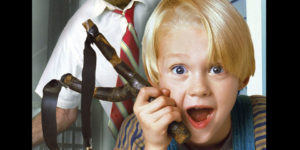 And what is Sukkis and why do we taka celebrate this Yom Tov? Nu, for those who know mamish nothing though you spent years roaming the hallways of the Yeshiva and day schools, it all started when the RBSO decreed as follows: “You shall sit in Sukkot for seven days; all citizens of Israel will sit in Sukkot. In order that your generations shall know that I enabled the children of Israel to dwell in Sukkot when I brought them out of Egypt, I am the Lord your G-d” (Vayikra 23:42-43.) Of course the Yiddin had no idea what all this meant, but many centuries later, when the codifiers of the Mishna and Gemora sat down to argue over pretty much everything, they also codified an entire Tractate of Gemora (Talmud) which they aptly named Sukkah, and in which they discuss every minute detail of its observance. From architecture to interior design, all can avada be found in the Gemora where we also learn about its height limitations and of course the role that decorations play.
And what is Sukkis and why do we taka celebrate this Yom Tov? Nu, for those who know mamish nothing though you spent years roaming the hallways of the Yeshiva and day schools, it all started when the RBSO decreed as follows: “You shall sit in Sukkot for seven days; all citizens of Israel will sit in Sukkot. In order that your generations shall know that I enabled the children of Israel to dwell in Sukkot when I brought them out of Egypt, I am the Lord your G-d” (Vayikra 23:42-43.) Of course the Yiddin had no idea what all this meant, but many centuries later, when the codifiers of the Mishna and Gemora sat down to argue over pretty much everything, they also codified an entire Tractate of Gemora (Talmud) which they aptly named Sukkah, and in which they discuss every minute detail of its observance. From architecture to interior design, all can avada be found in the Gemora where we also learn about its height limitations and of course the role that decorations play.
Beginning Sunday evening we’ll be celebrating the joyous Yom Tov of Sukkis, which avada you all know begins four nights after Yoim Kippur ends. It’s a holiday when we celebrate protection, avada we all know that protection is good, if you chap. And if you do, protection is avada and avada vichtig (critical). What’s pshat? Avada you recall, or at least should, that the RBSO gave the Yiddin full protection as they left Mitzrayim (Egypt), and for the 40 years that they were schlepping through the midbar. We commemorate the protective Ananey Hakovoid (Clouds of Glory) that surrounded the Yiddin during their sojourns in the midbar. Sukkis also commemorates how the Yiddin lived in temporary dwellings during that same time. We leave the safety and security of our houses and put ourselves under the direct protection of the RBSO, what could be better?
Sukkis is also the Yom Toiv where we can typically expect at least some rain, wind, and other destructive forces to wreak havoc on our dinner plans, and at times, even with our Sukkis. Speaking of rain, shtelt zich di shailo (the question arises): Is rain always considered a curse on Sukkis? Hey, weren’t we always taught that Mayim (water) is a siman brocho (sign of blessing from above?) What’s pshat? Can water be both a curse and a brocho? Avada the answer depends on who you ask. Say the RambaM, The Ritva, and The Meiri: rain is taka a curse but only on the first night of Sukkis, when there is a specific mitzvah to eat in the sukkah that we cannot fulfill due to the rain. Ober, say the Bikkurei Yaakov: the first night of Sukkis is the only time when rain is not considered a curse, as it increases the reward (and the dry cleaning bill) we receive for persevering and eating in the sukkah despite the inclement weather. The Aruch HaShulchan cites an opinion that rain is only considered a curse in the land of Israel but here in golus (Diaspora,) rain is gevaldig. The Chemdas HaYamim posits that rain is only considered a curse if it starts just when you get home from shul ober it’s not if the rain began erev Yom Tov. Got all that? Veyter. And the bottom line? Ver veyst! To the average oisvorf, rain is avada not good unless he’s sleeping.
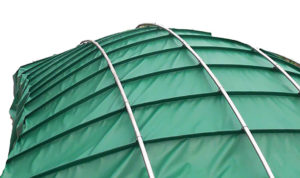 Some say that the first succoh was built by our zeyde Avrahom Oveenu who sat in his tent, with the flaps folded up on all four sides, so he could welcome weary wayfarers (guests) from every direction. Gishmak mamish! We are taught that all male adults and boys who are past the age of bar mitzvah are required to “laysheiv” (dwell or sit) in the Sukkah for the prescribed seven day period. Women and girls are exempt from the mitzvah, or commandment, to dwell or sit in a Sukkah, although, if they prefer to eat or sleep in a Sukkah, they are certainly permitted to do so. Avada some do so knowing that it comes with the ultimate in protection, if you chap; gishmak mamish (very enjoyable.)
Some say that the first succoh was built by our zeyde Avrahom Oveenu who sat in his tent, with the flaps folded up on all four sides, so he could welcome weary wayfarers (guests) from every direction. Gishmak mamish! We are taught that all male adults and boys who are past the age of bar mitzvah are required to “laysheiv” (dwell or sit) in the Sukkah for the prescribed seven day period. Women and girls are exempt from the mitzvah, or commandment, to dwell or sit in a Sukkah, although, if they prefer to eat or sleep in a Sukkah, they are certainly permitted to do so. Avada some do so knowing that it comes with the ultimate in protection, if you chap; gishmak mamish (very enjoyable.)
Efsher you were taka wondering why we celebrate Sukkis in the fall. Didn’t we leave Mitzrayim in the month of Nissan (typically April?) Nu, di-zelba (the same) kasha bothered The Tur Oirach Chaim (825) who taka asks it. Nu- did you ever imagine that an Oisvorf like yourself might one day ask the same kasha as does the Tur? Avada nisht (certainly not). Mistama you’ve gotten smarter reading the weekly postings of the heylige Oisvorfer. Asking the same kasha as the Tur? Impressive mamish, pat yourselves on the back. And not just does the Tur ask, he also had an answer which goes like this: The month of Nissan is in the spring when it is customary for people to dwell in cottages and sit in the shade of huts. At that time of year, who would notice us Yiddin doing something unique as everyone’s in the hut? How would they know that we dedicated Yiddin are doing so just to fulfill the RBSO’s commandment? Therefore, the Toirah commands us to build our Sukkahs in the month of Tishrei, when the rains set in and everyone leaves their cottages to return to their homes, and also to thank the RBSO for hovering over us with protective clouds. Ober in reality, this doesn’t work out too well because as soon as it’s raining, we’re all back indoors. Mistama (likely) you all know that on the first night, rain notwithstanding, we are commanded to wait for some period of time before having the meal indoors but practically speaking, if it’s raining, it’s a washout and indoors we all run. Efsher Sukkis should be moved back to the spring?
Another givaldige approach and one you should definitely discuss at the Yom Tov tish goes as follows. Says The Vilna Gaon azoy: the time to be celebrating Sukkis is taka now and we aren’t remembering the Clouds of Glory which initially protected the Yiddin when they left Mitzrayim in Nissan. Those clouds were taken away shortly thereafter when the Yiddin, nervous that Moishe had disappeared, created the golden calf. Rather, we are commemorating new clouds, the clouds which returned on the 15th day of Tishrei after the RBSO in His magnificence, forgave the Jewish people. These new clouds remained to surround and protect them for the duration of their sojourn in the wilderness. Says the Gaon so gishmak mamish: the Yiddin were forgiven on the 10th of Tishrei (Yom Kippur), and on the 11th Moishe commanded them regarding the building of the Mishkan. They brought their contributions for the Mishkan for two days (Shemos 36:3), the 12th and the 13th, and on the 14th Moishe realized that the donations were sufficient and announced that no more should be brought (36:6). On the following day, the 15th of Tishrei, the work began on the building of the Mishkan and on that day, the Clouds of Glory returned to the Jewish camp, which we celebrate and remember on Sukkis.
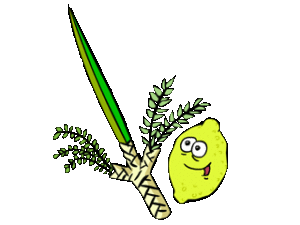 Says the heylige Toirah (Lev. 23:39): “But on the fifteenth day of the seventh month, when you have gathered in the fruit of the land, you shall keep a feast to the Lord seven days; on the first day shall be a shabbis, and on the eighth day shall be a shabbis. And you shall take for yourselves on the first day the fruit of a beautiful tree, date branches, a branch of a leafy tree, and willows of the brook and you shall rejoice before the Lord your God seven days.” Asks the Midrash Tanchumah, “Why is it called the first day, indeed it’s actually the 15th day of the month? Answer: The verse refers to it as the ‘first day’ because it’s the first day of the counting of new sins. On Yoim Kippur the Yiddin fast and daven and of course do t’shuva (repent.) On the first day of Sukkis the people take their fully adorned lulovim and dance in praise before the RBSO and He forgives them and says, ‘I will erase all your previous sins and start counting new sins from this day forward.’
Says the heylige Toirah (Lev. 23:39): “But on the fifteenth day of the seventh month, when you have gathered in the fruit of the land, you shall keep a feast to the Lord seven days; on the first day shall be a shabbis, and on the eighth day shall be a shabbis. And you shall take for yourselves on the first day the fruit of a beautiful tree, date branches, a branch of a leafy tree, and willows of the brook and you shall rejoice before the Lord your God seven days.” Asks the Midrash Tanchumah, “Why is it called the first day, indeed it’s actually the 15th day of the month? Answer: The verse refers to it as the ‘first day’ because it’s the first day of the counting of new sins. On Yoim Kippur the Yiddin fast and daven and of course do t’shuva (repent.) On the first day of Sukkis the people take their fully adorned lulovim and dance in praise before the RBSO and He forgives them and says, ‘I will erase all your previous sins and start counting new sins from this day forward.’
Says the Shulchan Aruch, Orach Chaim (529:2): “A man is obligated to be happy and good at heart on the festivals, he, his wife and children and whoever is around him. How does he make them happy? To the kinderlach (the minors) he gives roasted grain and nuts. He buys the women garments and jewelry, according to his means (or level of guilt.) And he is obligated to feed the strangers, orphans, widows as well as other poor people.”
And how does he make himself happy? Nu, avada we all chap that men have a way, in and out of the house, if you chap, to find happiness. Ober some taka ask why the Shulchan Oruch deals only with everyone else’s happiness and not his own. Answer: nothing makes a person happier than making others happy. Gishmak mamish.
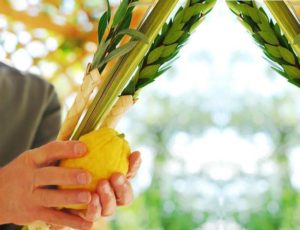 On Sukkis we are also commanded to take a lulav and esrog together. “On the first day you shall take the product of the beautiful (hadar) tree, branches of palm trees, thick branches of leafy trees, and willows of the brook and you shall rejoice before the Lord your God for seven days” (Vayikro (Leviticus) 23:40.) On this day and others, we avada like to compare size, girth and circumference. Does mine shokel (shake) more than yours?
On Sukkis we are also commanded to take a lulav and esrog together. “On the first day you shall take the product of the beautiful (hadar) tree, branches of palm trees, thick branches of leafy trees, and willows of the brook and you shall rejoice before the Lord your God for seven days” (Vayikro (Leviticus) 23:40.) On this day and others, we avada like to compare size, girth and circumference. Does mine shokel (shake) more than yours?
Some say that when the Beis Hamikdash (Temple) stood in Yerusholayim, the Yiddin used the lulav and esrog only on the first day. Only the Kohanim who served in the Beis Hamikdash used these for the rest of the holiday. This, of course, didn’t sit well with the lulav and esrog growers. Who was going to invest close to or over one hundred dollars for a set they could only show off for one day? They protested vehemently. And following its (The Beis Hamkidash) destruction, the rabbis, who mistama got a healthy cut off the top, taka, decreed that all Yiddin should taka shokel their lulavim and esrogim all seven days as a remembrance of Temple days. Talk about greasing the palm…..
The medrish (Vayikrah Rabba 30:12) tells us that these items are symbols of the importance of unity among different types of Yiddin. The bringing together of the “arbah minim” (four species) on Sukkis, represents the notion that all of the YIDDIN (Jews) are one, and should be viewed as such, regardless of their level of commitment to Judaism. Of course this isn’t reality; when was the last time you saw unity among Jews? Answer: sadly and nebech never! Let’s learn the medrish anyway, efsher you’ll feel inclined, while waiting for the rain to stop, to say a few words about the holiday.
The “esrog” (citron) has both a taste and a fragrance, thus representing those among us who possess Toirah knowledge and good deeds. The “lulav” (palm branch) which lacks fragrance but has a taste contained in the dates produced by the palm tree, depicts those Yiddin who possess Toirah knowledge but lack good deeds. The “hadas” (myrtle branch) possesses a fragrance but lacks a taste, reflecting those Yiddin who practice good deeds but do not engage in the study of the heylige Toirah. The “aravah” (willow) branch has neither a taste nor a fragrance, representing those amongst the YIDDIN who have no Toirah knowledge and do not engage in good deeds. The differences between us Yiddin may be substantial but, like the lulav and esrog which must be held together for the shokeling (waving) ritual, only when Yiddin come together, do they merit a brocho. Nebech (very sadly,) we still wait this day.
The Sefer Bahir, a kabbalistic work almost 2,000 years old, describes the four species as four parts of a human being:
- The Esrog represents the heart, the seat of our emotions.
2. The Hadas (myrtle) has leaves shaped like an eye.
3. The Lulav (date palm) represents the spine, from where our actions emanate.
4. The Aravah (willow) represents the lips, our speech.
The four species must be taken together as a unit. To achieve happiness, one must use all of one’s faculties in unison. We shouldn’t say one thing and feel another; yet another nice thought but rarely practiced. We must unify our feelings, our actions, our speech and our outlook. With all of these working together, we are well on the path to self-esteem, tranquility and joy; also fewer friends.
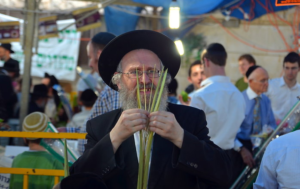 Raboyseyee: being happy seems to be part of the mitzvah, not always an easy task, but avada we are to do our best. Eating and spending time in the Sukkah, is one of but maybe two or some say three mitzvois that we can perform with our entire body. The other that comes to mind is a trip to the mikveh. Ober with nightmares many of you are just getting over from trips to the mikveh, uninvited encounters from strangers who wanted to shokel your lulav, if you chap, or have their lulav touch yours, where would you rather be?
Raboyseyee: being happy seems to be part of the mitzvah, not always an easy task, but avada we are to do our best. Eating and spending time in the Sukkah, is one of but maybe two or some say three mitzvois that we can perform with our entire body. The other that comes to mind is a trip to the mikveh. Ober with nightmares many of you are just getting over from trips to the mikveh, uninvited encounters from strangers who wanted to shokel your lulav, if you chap, or have their lulav touch yours, where would you rather be?
Chag somayach- a Gitten Yom Toiv-
The Oisvorfer
Yitz Grossman
Source URL: https://oisvorfer.com/succois-2016/